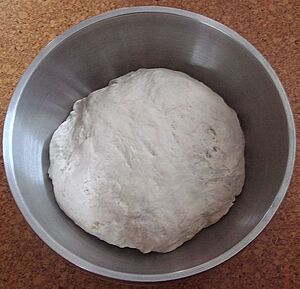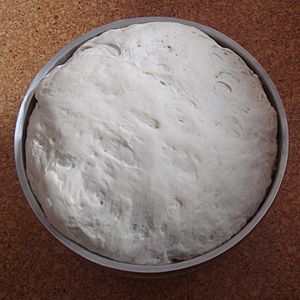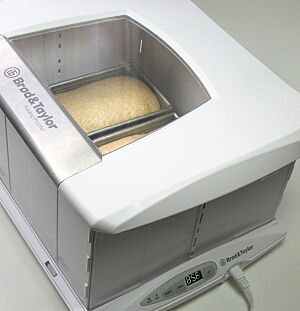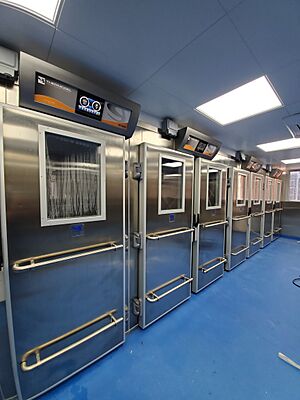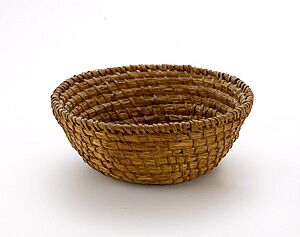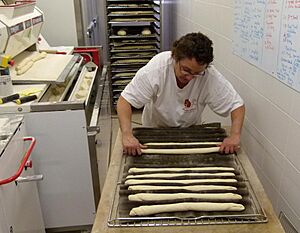Proofing (baking technique) facts for kids
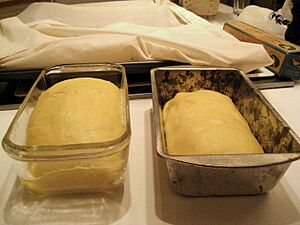
In cooking, proofing is a special step when you make yeast bread and other baked goods. It's when the dough gets to rest and rise one last time before you bake it. During this rest, tiny yeast cells in the dough eat sugars and make gases. These gases make the dough puff up and become light.
Sometimes, "proofing" can also mean checking if your dry yeast is alive. You mix it with warm water and a little sugar. If the yeast is active, it will create a foamy layer on top of the water. This shows it's ready to make your dough rise!
Rest periods for dough are not always called "proofing." They might be called "Allow dough to rise," "first rise," or "bulk fermentation." The term "final proof" or "shaped proof" means the very last rise before baking.
How Dough Rises
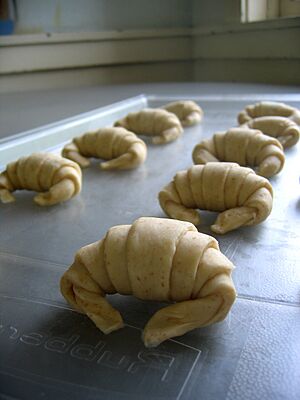
Making bread with yeast involves a mix of working the dough and letting it rest. When you work the dough, you might be mixing, kneading, folding, dividing it into pieces, shaping it, or putting it into a bread pan. After these work times, the dough needs to rest quietly.
Some rest times include autolyse, bulk fermentation, and proofing. Proofing is the specific name for the dough's final rise after it has been shaped and just before it goes into the oven.
Some breads start with an autolyse rest. This happens after you first mix just the flour and water, but before you add yeast, salt, or other things. This rest helps the flour soak up water better and helps the gluten (which gives bread its chewiness) and starches line up. This can make the bread taste and look better.
Proofing the yeast is when you mix dry yeast with warm water and let it sit for a short time. This helps the yeast wake up and get ready to work. You can also test if your yeast is alive by mixing it with warm water and a little sugar. After a short rest, if the yeast is alive, it will make foam on top of the water. This foam means the yeast is eating the sugar and producing gas! Usually, you use about 60 milliliters (1/4 cup) of water that's around 40-46°C (105-115°F) and 2 grams (1/2 teaspoon) of sugar.
Fermentation starts when active baker's yeast or a starter (like for sourdough) is added to flour and water. Enzymes in the flour and yeast create sugars. The yeast then eats these sugars and produces carbon dioxide gas (which makes the dough rise) and alcohol (which gives the baked bread flavor). Sourdough starters also make lactic and acetic acids, adding even more flavor.
Different types of bread have different ways of being made. Some are called straight doughs, which means they are mixed only once. During their main rise, you might "punch down" or "deflate" the dough to let out some gas. Other breads are sponge doughs, which need to be mixed more than once.
Overproofing happens if dough rests for too long. The gas bubbles inside grow too big, pop, and the dough can collapse. If you bake overproofed dough, the bread won't have a good structure.
You can often tell if dough has risen enough by using the "poke method." Gently poke the dough with your finger.
- If the dough springs back right away, it's underproofed and needs more time.
- If the indent from your poke slowly springs back, or if it stays, the dough is likely ready.
A properly proofed bread will rise well in the oven and have a good texture. If it's under- or overproofed, it will be denser. An overproofed bread might even collapse in the oven because its structure can no longer hold all the gas.
Retarding means slowing down the yeast activity by putting the dough in a cold place, like a refrigerator. This is often done with sourdough bread to help it develop its special sour flavor. Cold fermentation can also add flavor to other artisan breads.
Proofing Tools
To get consistent results and stick to baking schedules, bakers use special tools to control how fast and how well dough ferments.
A dough proofer is a warm box or chamber that helps dough rise. It has warm temperatures and controlled humidity. The warmth makes the yeast more active, so it produces more carbon dioxide and the dough rises faster and higher. Dough is usually proofed in a proofer before baking, but it can also be used for the first big rise. Commercial bakeries use large proofers, while home bakers might use their oven with a bowl of hot water, or a special electric proofer for home use.
A dough retarder is like a refrigerator that slows down yeast activity. Lowering the dough's temperature makes it rise slower and longer. This slow rise allows more complex flavors to develop in the bread. For sourdough, cold temperatures help the good bacteria (Lactobacilli) produce more of the acids that give sourdough its unique taste. To keep the dough from drying out, retarders have very little air movement. Home bakers can just cover their dough and put it in a regular refrigerator.
A banneton is a type of basket that helps shaped bread loaves keep their form while they proof. These baskets are also called brotforms or proofing baskets. They are great for doughs that are too soft or wet to hold their shape on their own. You usually take the bread out of the banneton before baking. Bannetons are often made from rattan, but can also be made from cane, wood pulp, terracotta, or plastic. Sometimes, a banneton has a cloth liner, usually made of linen, to stop the dough from sticking. As you use them, bannetons get a little flour in their weave, which makes them even more non-stick. They help shape the loaf and also wick away a little moisture from the crust. Bannetons come in round or oblong shapes.
Another tool is a couche (pronounced koosh), which is a proofing cloth. These are used for longer loaves, like baguettes. Couches are typically made of linen. Flour collects in the fabric's weave, making a surface that the dough won't stick to. You dust the couche lightly with flour, then place the shaped doughs on it. You can make folds in the cloth to separate and support the loaves as they rise.
Breads like sandwich loaves and brioche are usually proofed right in the bread pan they will be baked in.
See also
 In Spanish: Levantamiento (cocina) para niños
In Spanish: Levantamiento (cocina) para niños


